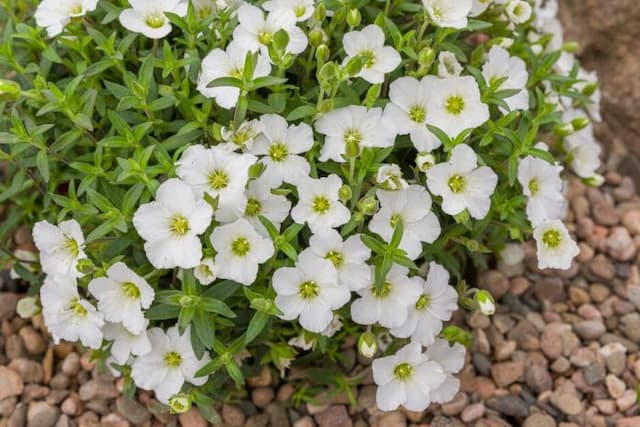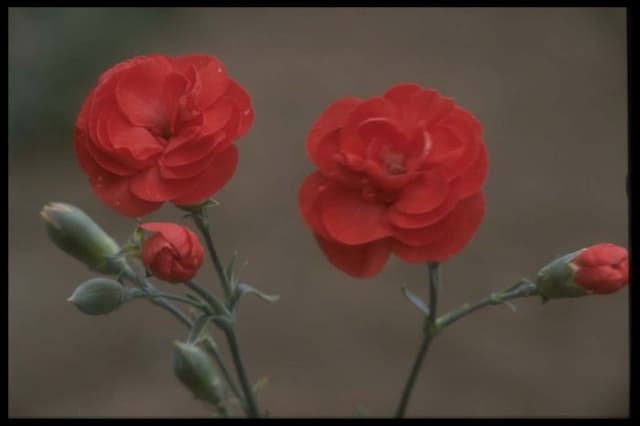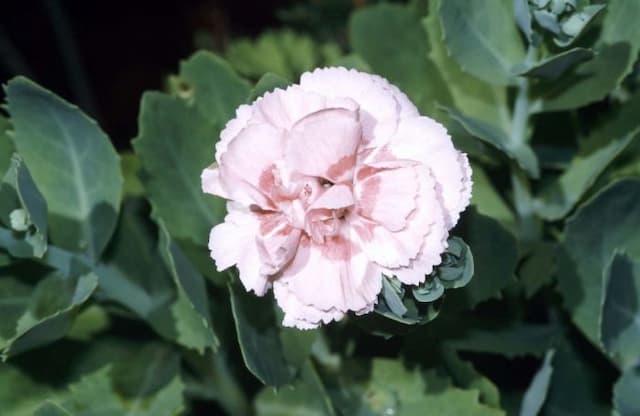Baby's breath Gypsophila elegans 'Covent Garden'

ABOUT
The 'Covent Garden' baby's breath is a graceful and airy plant cherished for its abundance of tiny, delicate white flowers that resemble a frothy cloud of blossoms. Each individual bloom presents with a simple yet elegant structure, with a set of five small petals that surround a central core. These blooms are tightly clustered together, creating a soft and snowy effect that is often used to fill in gaps and add texture to garden arrangements or floral bouquets. The foliage of this variety is a muted green, composed of narrow leaves that almost blend into the background as the spectacular mass of white flowers takes center stage. The stems of 'Covent Garden' are slender and branching, giving the plant an overall feathery appearance which sways gently in the breeze, adding movement and lightness to the landscape. It is commonly used as a background or as a filler plant, complementing more robust flowers with its delicate form and blossoms, giving a soft contrast to bolder features in the garden.
About this plant
 Names
NamesFamily
Caryophyllaceae
Synonyms
Baby's Breath, Showy Baby’s-breath, Covent Garden Gypsophila
Common names
Gypsophila elegans.
 Toxicity
ToxicityTo humans
Baby's breath, which is the common name for Gypsophila elegans 'Covent Garden', is generally considered non-toxic to humans. There are no widely recognized poisonous attributes or serious adverse effects associated with accidental ingestion of this plant by humans. Keep in mind that individual sensitivities can vary, and consuming non-food plants is generally not advisable.
To pets
Baby's breath is mildly toxic to pets if ingested. While it is not usually life-threatening, consumption of this plant can lead to gastrointestinal upset in dogs and cats, which may include symptoms such as vomiting or diarrhea. Care should be taken to prevent pets from eating this plant, and if ingestion does occur, it is advisable to monitor them for any signs of discomfort and consult a veterinarian if any worrisome symptoms develop.
 Characteristics
CharacteristicsLife cycle
Annuals
Foliage type
Deciduous
Color of leaves
Green
Flower color
White
Height
1-2 feet (30-60 cm)
Spread
1-2 feet (30-60 cm)
Plant type
Herb
Hardiness zones
3-7
Native area
Asia
Benefits
 General Benefits
General Benefits- Aesthetic Appeal: Adds delicate beauty to gardens with its small, white, cloud-like flowers.
- Attracts Pollinators: Provides nectar for bees, butterflies, and other beneficial insects.
- Companion Planting: Works well in floral arrangements and in the garden to enhance the growth of nearby plants.
- Drought Tolerance: Once established, it is relatively drought-resistant, requiring minimal watering.
- Easy to Grow: Suitable for gardeners of all levels due to its low maintenance and easy cultivation.
- Fast Growth: Quickly grows to full size, adding charm to garden spaces in a short time frame.
- Cut Flower: Its long-lasting blooms make it a popular choice for fresh bouquets and flower arrangements.
- Self-Seeding: Can reseed itself, ensuring a continuous presence without replanting every year.
- Ground Cover: Dense growth habit can help suppress weeds and cover bare spots in the landscape.
- Versatility: Suitable for a variety of garden styles including cottage gardens, rockeries, and borders.
 Medical Properties
Medical PropertiesThis plant is not used for medical purposes.
 Air-purifying Qualities
Air-purifying QualitiesThis plant is not specifically known for air purifying qualities.
 Other Uses
Other Uses- Gypsophila elegans 'Covent Garden', commonly known as baby's breath, can be used as a natural fabric dye, providing a soft, pastel color to textiles.
- When dried and powdered, the stems of baby's breath can be used as a natural abrasive in homemade cleaners for scrubbing surfaces gently.
- The delicate flowers of baby's breath can be incorporated into homemade paper to add texture and visual interest to the final product.
- Baby's breath can be used in potpourri mixes to lend a light, airy appearance and can be scented with essential oils to enhance the aroma.
- Florists sometimes use the dried stalks of baby's breath to create the structure of floral wreaths or as support stakes for other plants and flowers.
- The plant can be included in a compost pile, where its stems help to introduce air pockets, thus aiding in the composting process and improving aeration.
- Enthusiasts of miniature scenery and model railroading use dried baby's breath to simulate trees and shrubs, adding realism to their dioramas and layouts.
- Baby's breath can be used in crafting to make delicate and natural-looking flower crowns for festivals, weddings, or other special events.
- An infusion of baby's breath can be used to create a fragrant rinse for linens, imparting a gentle, floral scent to bedding and towels.
- Because of its lightness and volume, baby's breath is often used as a filler in gift baskets to enhance the presentation of products and add to the aesthetic appeal.
Interesting Facts
 Feng Shui
Feng ShuiThe Baby's Breath is not used in Feng Shui practice.
 Zodiac Sign Compitability
Zodiac Sign CompitabilityThe Baby's Breath is not used in astrology practice.
 Plant Symbolism
Plant Symbolism- Purity: Gypsophila, also known as baby's breath, is commonly associated with purity due to its delicate and innocent appearance, often used in bridal bouquets and christening ceremonies.
- Innocence: The small, white flowers of baby's breath symbolize innocence and a pure heart, making it a popular choice for conveying a message of untouched and simple beauty.
- Eternal Love: Because it's a staple in wedding decorations, baby's breath has come to represent everlasting love, symbolizing the unbreakable bonds of marriage.
- Support: The way baby's breath fills out a floral arrangement symbolizes support and the idea of being there for someone, much like its role in complementing other flowers in a bouquet.
- Freedom: Baby's breath is often used in arrangements that aim to convey a sense of lightness and freedom, perhaps due to its airy and delicate structure that seems to float amongst other flowers.
 Water
WaterBaby's Breath requires regular watering to keep the soil moist but not waterlogged. During the growing season, water the plant thoroughly once a week with about one gallon of water per square yard. Adjust the amount of water during periods of heavy rainfall or drought. Overwatering can lead to root rot, so it is crucial to ensure proper drainage. Reduce watering in the winter when the plant is dormant.
 Light
LightBaby's Breath thrives best in full sunlight with at least six hours of direct light daily. It prefers a spot that receives bright and unfiltered light throughout the day. However, it can tolerate some light shade, especially in regions with very intense midday sun.
 Temperature
TemperatureBaby's Breath performs optimally in temperatures between 60°F and 75°F and can survive in temperatures as low as 40°F and as high as 80°F. Frost can damage the plant, so it's best to avoid exposing it to temperatures below the freezing point.
 Pruning
PruningPrune Baby's Breath after the main flowering season to encourage a second bloom and maintain plant shape. Deadheading spent flowers regularly throughout the season can also promote continued blooming. The best time for heavy pruning is late winter or early spring, just before new growth begins.
 Cleaning
CleaningAs needed
 Soil
SoilBaby's Breath prefers a well-draining soil mix with plenty of organic matter such as compost or peat moss. A sandy loam or a commercial potting mix designed for flowering plants is ideal. Ensure the pH of the soil is slightly alkaline, around 7.0 to 7.5.
 Repotting
RepottingBaby's Breath does not typically require frequent repotting. It can be repotted once it outgrows its current container or every two to three years to refresh the soil.
 Humidity & Misting
Humidity & MistingBaby's Breath thrives in average room humidity levels. It does not require any special humidity considerations, making it adaptable to most indoor environments.
 Suitable locations
Suitable locationsIndoor
Ensure bright light and good air flow for Baby's Breath to thrive indoors.
Outdoor
Place Baby's Breath in full sun with well-draining soil outdoors.
Hardiness zone
3-9 USDA
 Life cycle
Life cycleGypsophila elegans 'Covent Garden', commonly known as Baby's Breath, begins its life as a seed that germinates when soil temperatures are right and moisture is present. After germination, the seedling develops into a rosette of foliage at the ground level before sending up erect stems. As the plant matures, these stems become branched and start to display numerous small, delicate flowers, typically white or pink, which are highly valued for their airy appearance in floral arrangements. After flowering, the plant sets seed, which are dispersed by wind or other means to facilitate the spread of the species. Once the seeds are dispersed, the parent plant usually dies, completing its annual life cycle. Baby's Breath is often grown as an annual, meaning all these stages from germination to seed dispersal occur within a single growing season.
 Propogation
PropogationPropogation time
Spring-Summer
Gypsophila elegans 'Covent Garden', commonly known as baby's breath, is typically propagated through seeds. The best time for sowing baby's breath seeds is in spring, after the danger of frost has passed, to allow for a full growing season. The seeds of baby's breath are small, so they should be lightly scattered on the surface of the soil, as they require light to germinate. To promote an even spread, seeds can be mixed with sand before sowing. The seedbed should be kept moist until germination occurs, usually within 10 to 20 days. Once the seedlings have grown enough to handle, usually a few inches tall, they can be thinned out or transplanted to allow for proper growth spacing. Baby's breath thrives in well-draining soil and full sun, making it relatively easy to grow from seed with minimal special care.



![Pink [Tequila Sunrise]](/_next/image?url=https%3A%2F%2Fplants-admin.emdemapps.com%2Fimages%2Fplants%2F%2Fimages%2F604b5d995d06e.png&w=640&q=75)





